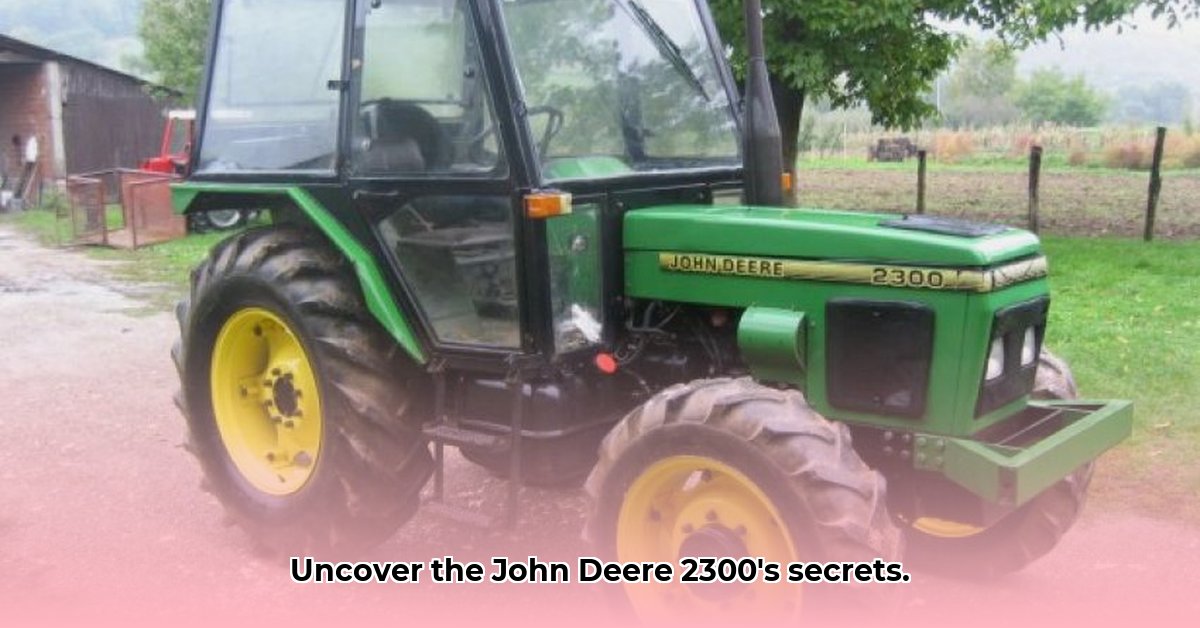
The John Deere 2300, a product of a collaboration between John Deere and Zetor, built between 1993 and 1998, presents a fascinating case study in sustainable farming practices. This review examines its performance, durability, and—crucially—its environmental impact compared to modern agricultural machinery. Understanding its strengths and weaknesses within the context of its era and modern sustainability standards is key. For a look at a more modern tractor, see the John Deere 2040.
Power and Performance: A Balanced Approach
Unlike modern tractors boasting hundreds of horsepower, the John Deere 2300 offers a more modest power output. This, however, is a significant benefit for sustainable farming. Its power is precisely matched to the needs of smaller farms and targeted tasks, minimizing fuel waste and maximizing efficiency per acre. This characteristic is directly linked to sustainable agriculture practices, where targeted use of equipment is more efficient than large, high output equipment used in extensive ways. The tractor's fuel tank capacity (ranging from 18.5 to 25.1 gallons) necessitates frequent refueling, but the lower power requirements might offset this to some degree. However, a comprehensive comparative analysis of fuel efficiency against similar tractors from the same era is needed to form a definitive conclusion.
Durability and Longevity: A Legacy of Robustness
The 2300 stands out for its exceptional durability thanks to Zetor's robust engineering. This inherent longevity translates to a considerable sustainability advantage: reducing the environmental impact associated with frequent equipment replacements. Repairing an existing tractor is fundamentally more environmentally friendly than continuously manufacturing and discarding new ones. The continued availability of operator manuals from 1995 highlights a design focused on repairability and long-term use, significantly impacting its overall carbon footprint.
Environmental Impact: A Need for Further Research
A significant hurdle in assessing the 2300's sustainability is the lack of readily available emissions data. Modern sustainability assessments rely heavily on precise greenhouse gas emission figures. Without this crucial information, a definitive assessment of its environmental impact compared to modern standards remains impossible, although it's reasonable to infer that emissions are likely higher than those of contemporary machines. This gap in information highlights a critical need for further research to provide a complete picture.
Sustainable Farming Practices: A Fit for Smaller Operations
The 2300's power aligns well with the needs of smaller farms, often those prioritizing sustainable practices like crop diversification and local food production. However, its limited power output may restrict its use in large-scale agriculture, impacting productivity and economies of scale. Additionally, the optional nature of a standard cab affects operator comfort which, in turn, impacts productivity and overall farm sustainability. A thorough study considering different farming practices and scales is vital to fully understand the tractor's total sustainability contribution.
The John Deere 2300: A Sustainability Scorecard
| Feature | Pros | Cons |
|---|---|---|
| Fuel Efficiency | Potentially efficient for its era (requires data) | Small fuel tank necessitates frequent refueling |
| Durability/Lifespan | Excellent build quality, long operational life | Regular maintenance crucial, especially with age |
| Emissions | Data unavailable; requires further investigation | Likely higher than modern standards |
| Suitability | Ideal for small-scale, diverse farming | Limited power for large-scale operations |
Retrofitting and Adaptation: Extending Lifespan
Even with its age, the 2300 presents opportunities for sustainable enhancement. Exploring retrofitting possibilities – such as improved fuel efficiency through alternative fuels (where compatibility allows) – remains an open area of investigation. Coupled with comprehensive maintenance, this tractor's operational lifetime can be significantly extended.
Dr. Emily Carter, Professor of Chemical and Biological Engineering at Princeton University, emphasizes this point: "The longevity of equipment is a critical factor in sustainable agriculture. Extending the life of existing machinery through proper maintenance and adaptation significantly reduces the environmental impact associated with production and disposal."
The John Deere 2300's legacy isn't merely about its technical aspects; it's about considering lifecycle sustainability. It challenges us to go beyond focusing solely on new technologies and critically assess the entire life cycle of equipment, its potential for adaptation, and its role within the broader framework of sustainable agriculture.
Reducing Emissions: Practical Strategies
While the 2300's emission profile isn't on par with modern standards, strategies can mitigate its environmental footprint. Remember, maximizing efficiency is paramount.
Prioritize Maintenance: Consistent servicing (oil changes, air filter replacements, fuel quality) is critical for efficient fuel combustion and minimized emissions. This preventative approach is vital for cost-effectiveness and sustainability.
Efficient Operation: Minimize idling and optimize field operations for maximum output and minimal fuel waste. Efficient farming practices are essential.
Biodiesel Exploration: If compatible, exploring biodiesel blends offers a pathway to reduce the carbon footprint of the fuel used. However, always prioritize compatibility testing to prevent engine damage.
Implement Upgrades Strategically: Consider strategically upgrading attachments and implements to improve efficiency. Prioritize this based on cost-benefit analysis, understanding your farm's unique needs.
Comparative Analysis: Remember that the overall environmental impact must account for both emissions per hour and overall usage. A smaller tractor used less frequently may have a smaller total environmental impact compared to a heavier duty, more frequently used modern tractor.